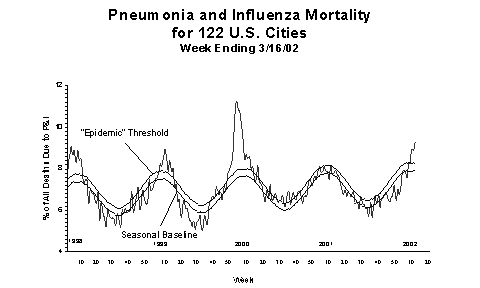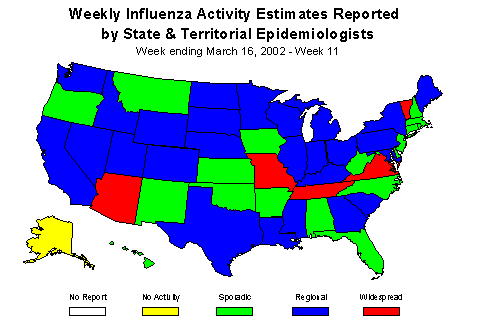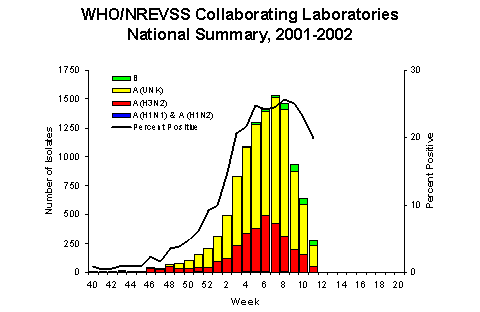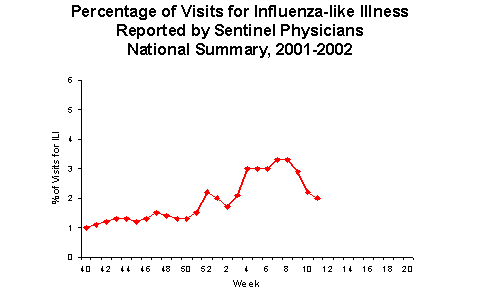Error processing SSI file
Error processing SSI file
Weekly Report: Influenza Summary Update
Week ending March 16, 2002-Week 11
Error processing SSI fileThe following information may be quoted:
Synopsis:
During week 11 (March 10-16, 2002)*, 276 (19.8%) of 1,395 respiratory specimens tested by World Health Organization (WHO) and National Respiratory Virus Surveillance System (NREVSS) laboratories were positive for influenza. The overall proportion of patient visits to sentinel physicians for influenza-like illness (ILI) was 2.0%, which is above the national baseline of 1.9%. The proportion of deaths attributed to pneumonia and influenza was 9.3%, which is above the epidemic threshold of 8.2% for week 11. Five state and territorial health departments reported widespread influenza activity, 26 reported regional activity, 18 reported sporadic activity, and 1 reported no influenza activity **.
Laboratory Surveillance*:
During week 11, WHO and NREVSS laboratories reported 1,395 specimens tested for influenza viruses, of which 276 (19.8%) were positive. Forty-five influenza A(H3N2) viruses, 1 influenza A(H1N1) virus, 192 unsubtyped influenza A viruses, and 38 influenza B viruses were identified. During the past 3 weeks (weeks 9-11), 34% of the specimens tested for influenza in the East North Central region were positive. In the East South Central, New England, West North Central, and South Atlantic regions the percentage of respiratory specimens testing positive for influenza ranged from 24% to 32% and in the Mountain, West South Central, and Mid-Atlantic regions the percentage of respiratory specimens testing positive for influenza ranged from 16% to 18%. In the Pacific region 7% of specimens tested were positive for influenza.
Since September 30, WHO and NREVSS laboratories have tested a total of 69,323 specimens for influenza viruses and 11,041 (15.9%) were positive. Of the 11,041 isolates identified, 10,741 (97%) were influenza A viruses and 300 (3%) were influenza B viruses. Three thousand eighty-four (29%) of the 10,741 influenza A viruses identified have been subtyped; 3,045 (99%) were H3 viruses and 39 (1%) were H1 viruses. Thirty-eight percent of the influenza B isolates reported this season were identified in the Mid-Atlantic region.
Antigenic Characterization:
CDC has antigenically characterized 328 influenza viruses collected from U.S. laboratories since October 1: 276 influenza A(H3N2) viruses, 5 influenza A H1 viruses, and 47 influenza B viruses. The influenza A (H3N2) and A H1 viruses were similar to the vaccine strains A/Panama/2007/99 (H3N2) and A/New Caledonia/ 20/99 (H1N1), respectively. One of the H1 viruses is an H1N2 virus from a patient specimen collected in Wisconsin in December. Two additional H1N2 viruses have been identified from patient specimens collected during July and September in Texas and Nevada, respectively.
Click here for more information about influenza A(H1N2) viruses
Influenza B viruses currently circulating worldwide can be divided into 2 antigenically distinct lineages, B/Yamagata/16/88 and B/Victoria/2/87. Viruses of the B/Yamagata lineage have circulated widely since 1990. The B component of the current influenza vaccine belongs to the B/Yamagata lineage. Viruses of the B/Victoria lineage had not been identified outside of Asia between 1991 and March 2001. Since March 2001, B/Victoria lineage viruses have been identified in Canada, China, Hong Kong, India, Italy, Japan, the Netherlands, Oman, the Philippines, Thailand, and the United States (Hawaii, Maryland, New Jersey, New York, and Wisconsin). CDC has antigenically characterized 47 influenza B viruses received from U.S. laboratories and collected since October 1; 34 belonged to the B/Yamagata lineage and 13 belonged to the B/Victoria lineage. Of the 34 B/Yamagata lineage viruses, 12 were similar to the vaccine strain, B/Sichuan/379/99, and 22 showed somewhat reduced titers to ferret antisera produced against B/Sichuan/379/99. The B component of the current influenza vaccine is expected to provide lower levels of protection against viruses of the B/Victoria lineage.
Composition of the 2002-03 Influenza Vaccine:
The Food and Drug Administration's Vaccine and Related Biological Products Advisory Committee recommended that the 2002-03 trivalent influenza vaccine for the United States contain A/New Caledonia/20/99-like (H1N1), A/Moscow/10/99-like (H3N2), and B/Hong Kong/330/2001-like viruses. The influenza B component of the 2002-03 season vaccine is a virus of the B/Victoria lineage. The A(H1N1) and A(H3N2) components are the same as those for the 2001-02 season vaccine. This recommendation was based on antigenic analyses of recently isolated influenza viruses, epidemiologic data, and postvaccination serologic studies in humans.
Pneumonia and Influenza (P&I) Mortality Surveillance:
During week 11, the percentage of all deaths due to pneumonia and influenza as reported by the vital statistics offices of 122 U.S. cities was 9.3%. This percentage is above the epidemic threshold of 8.2% for week 11.

Influenza-like Illness Surveillance *:
During week 11, 2.0% of patient visits to U.S. sentinel physicians were due to ILI. This is above the national baseline of 1.9%. On a regional level, the percentage of visits for ILI ranged from 0.7% to 4.8%.*** Due to wide variability in regional level data, it is not possible to calculate region-specific baselines and it is not appropriate to apply the national baseline to regional level data.
Influenza Activity as Assessed by State and Territorial Epidemiologists**:
Influenza activity was reported as widespread in 5 states (Arizona, Missouri, Tennessee, Vermont, and Virginia), and regional in 26 states (California, Colorado, Georgia, Idaho, Illinois, Indiana, Kentucky, Louisiana, Maine, Maryland, Michigan, Minnesota, Mississippi, Nebraska, Nevada, New York, North Dakota, Ohio, Pennsylvania, South Carolina, South Dakota, Texas, Utah, Washington, Wisconsin, and Wyoming). Eighteen states, New York City, and Washington D.C. reported sporadic influenza activity, and Alaska reported no influenza activity.

* Reporting is incomplete for this week. Numbers may change as more reports are received.
** Influenza activity is defined as influenza-like illness and/or culture-confirmed influenza.
*** Surveillance Regions: New England (Connecticut, Maine, Massachusetts, New Hampshire, Vermont, Rhode Island); Mid-Atlantic (New Jersey, New York City, Pennsylvania, Upstate New York); East North Central (Illinois, Indiana, Michigan, Ohio, Wisconsin); West North Central (Iowa, Kansas, Minnesota, Missouri, Nebraska, North Dakota, South Dakota); South Atlantic (Delaware, Florida, Georgia, Maryland, North Carolina, South Carolina, Virginia, Washington, D.C., West Virginia); East South Central (Alabama, Kentucky, Mississippi, Tennessee); West South Central (Arkansas, Louisiana, Oklahoma, Texas); Mountain (Arizona, Colorado, Idaho, Montana, Nevada, New Mexico, Utah, Wyoming); Pacific (Alaska, California, Hawaii, Oregon, Washington)
Report prepared March 21, 2002
Error processing SSI file
